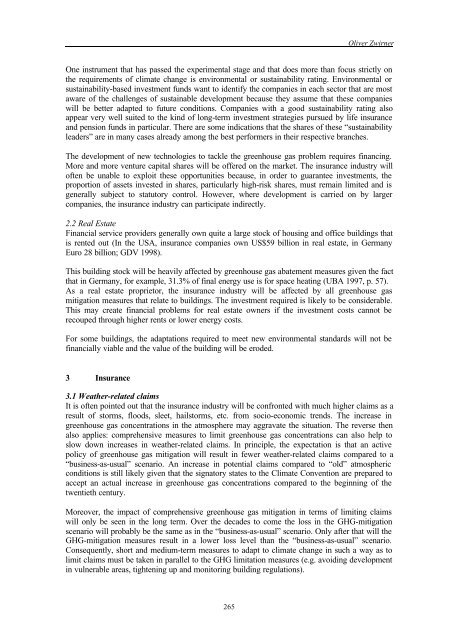sectoral economic costs and benefits of ghg mitigation - IPCC
sectoral economic costs and benefits of ghg mitigation - IPCC
sectoral economic costs and benefits of ghg mitigation - IPCC
Create successful ePaper yourself
Turn your PDF publications into a flip-book with our unique Google optimized e-Paper software.
Oliver Zwirner<br />
One instrument that has passed the experimental stage <strong>and</strong> that does more than focus strictly on<br />
the requirements <strong>of</strong> climate change is environmental or sustainability rating. Environmental or<br />
sustainability-based investment funds want to identify the companies in each sector that are most<br />
aware <strong>of</strong> the challenges <strong>of</strong> sustainable development because they assume that these companies<br />
will be better adapted to future conditions. Companies with a good sustainability rating also<br />
appear very well suited to the kind <strong>of</strong> long-term investment strategies pursued by life insurance<br />
<strong>and</strong> pension funds in particular. There are some indications that the shares <strong>of</strong> these “sustainability<br />
leaders” are in many cases already among the best performers in their respective branches.<br />
The development <strong>of</strong> new technologies to tackle the greenhouse gas problem requires financing.<br />
More <strong>and</strong> more venture capital shares will be <strong>of</strong>fered on the market. The insurance industry will<br />
<strong>of</strong>ten be unable to exploit these opportunities because, in order to guarantee investments, the<br />
proportion <strong>of</strong> assets invested in shares, particularly high-risk shares, must remain limited <strong>and</strong> is<br />
generally subject to statutory control. However, where development is carried on by larger<br />
companies, the insurance industry can participate indirectly.<br />
2.2 Real Estate<br />
Financial service providers generally own quite a large stock <strong>of</strong> housing <strong>and</strong> <strong>of</strong>fice buildings that<br />
is rented out (In the USA, insurance companies own US$59 billion in real estate, in Germany<br />
Euro 28 billion; GDV 1998).<br />
This building stock will be heavily affected by greenhouse gas abatement measures given the fact<br />
that in Germany, for example, 31.3% <strong>of</strong> final energy use is for space heating (UBA 1997, p. 57).<br />
As a real estate proprietor, the insurance industry will be affected by all greenhouse gas<br />
<strong>mitigation</strong> measures that relate to buildings. The investment required is likely to be considerable.<br />
This may create financial problems for real estate owners if the investment <strong>costs</strong> cannot be<br />
recouped through higher rents or lower energy <strong>costs</strong>.<br />
For some buildings, the adaptations required to meet new environmental st<strong>and</strong>ards will not be<br />
financially viable <strong>and</strong> the value <strong>of</strong> the building will be eroded.<br />
3 Insurance<br />
3.1 Weather-related claims<br />
It is <strong>of</strong>ten pointed out that the insurance industry will be confronted with much higher claims as a<br />
result <strong>of</strong> storms, floods, sleet, hailstorms, etc. from socio-<strong>economic</strong> trends. The increase in<br />
greenhouse gas concentrations in the atmosphere may aggravate the situation. The reverse then<br />
also applies: comprehensive measures to limit greenhouse gas concentrations can also help to<br />
slow down increases in weather-related claims. In principle, the expectation is that an active<br />
policy <strong>of</strong> greenhouse gas <strong>mitigation</strong> will result in fewer weather-related claims compared to a<br />
“business-as-usual” scenario. An increase in potential claims compared to “old” atmospheric<br />
conditions is still likely given that the signatory states to the Climate Convention are prepared to<br />
accept an actual increase in greenhouse gas concentrations compared to the beginning <strong>of</strong> the<br />
twentieth century.<br />
Moreover, the impact <strong>of</strong> comprehensive greenhouse gas <strong>mitigation</strong> in terms <strong>of</strong> limiting claims<br />
will only be seen in the long term. Over the decades to come the loss in the GHG-<strong>mitigation</strong><br />
scenario will probably be the same as in the “business-as-usual” scenario. Only after that will the<br />
GHG-<strong>mitigation</strong> measures result in a lower loss level than the “business-as-usual” scenario.<br />
Consequently, short <strong>and</strong> medium-term measures to adapt to climate change in such a way as to<br />
limit claims must be taken in parallel to the GHG limitation measures (e.g. avoiding development<br />
in vulnerable areas, tightening up <strong>and</strong> monitoring building regulations).<br />
265
















